

Greyfriars Kirk. Greyfriars Kirk Feature Page on Undiscovered Scotland. Hidden away behind other buildings is one of the gems of Edinburgh's Old Town, the Kirk of the Greyfriars: also known as the Greyfriars Tolbooth and Highland Kirk, or just simply Greyfriars Kirk.

Churches are usually amongst the easiest of buildings to find, announcing their presence with a tower or steeple. Not so Greyfriars Kirk, and as a result finding it takes a little detective work. Your starting point should be the circular stone tower of the beautiful Museum of Scotland building. Looking across the road to its west you see a pub, Greyfriars Bobby's Bar. THE GRASSMARKET- GREYFRIAR'S KIRK. Greyfriars Kirk is now home to the congregation of Greyfriar Tolbooth and Highland Kirk.
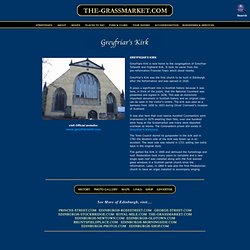
It took its name from the pre-reformation Francian friary which stood nearby. Greyfriar's Kirk was the first church to be built in Edinburgh after the Reformation and was opened in 1620. It plays a significant role in Scottish history because it was here, in front of the pulpit, that the National Covenant was presented and signed in 1638, This was an extremely important document in Scottish history and an original copy can be seen in the visitor's centre. The kirk was used as a barracks from 1650 to 1653 during Oliver Cromwell's invasion of Scotland.
It was also here that over twelve hundred Covenanters were imprisoned in 1679 awaiting their fate, over one hundred were hung at the Grassmarket and many were deported overseas as slaves. Scotland, Edinburgh - Greyfriars kirk. Greyfriars Tolbooth and Highland Kirk. Covenanter. An illegal conventicle.
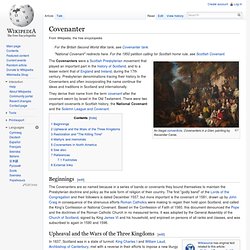
Covenanters in a Glen, painting by Alexander Carse. The Covenanters were a Scottish Presbyterian movement that played an important part in the history of Scotland, and to a lesser extent that of England and Ireland, during the 17th century. Presbyterian denominations tracing their history to the Covenanters and often incorporating the name continue the ideas and traditions in Scotland and internationally. Beginnings[edit]
Covenanters' Prison - Greyfriars Kirkyard, Edinburgh. The following inscription is from a plaque erected at Greyfriars' Churchyard, Edinburgh, and unveiled on 30 November 2007 by John Campbell, Treasurer of the Scottish Covenanter Memorials Association: THE COVENANTERS' PRISONBehind these gates lies part of the southern section of Greyfriars Kirkyard which was used in 1679 as a prison for over one thousand supporters of the National Covenant who had been defeated by Government forces at the battle of Bothwell Brig on 22 June.
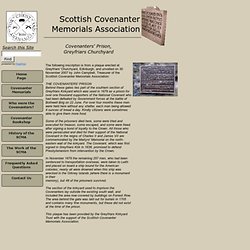
For over four months these men were held here without any shelter, each man being allowed 4 ounces of bread a day. George Mackenzie (lawyer) George Mackenzie.
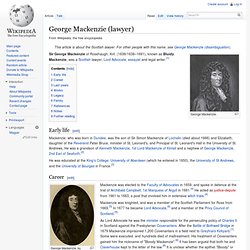
Greyfriars Kirkyard. Greyfriars Kirkyard is the graveyard surrounding Greyfriars Kirk in Edinburgh, Scotland.
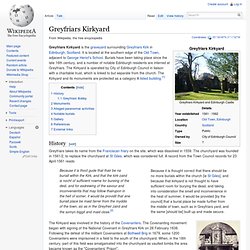
It is located at the southern edge of the Old Town, adjacent to George Heriot's School. Burials have been taking place since the late 16th century, and a number of notable Edinburgh residents are interred at Greyfriars. Edinburgh Royal Mile- Greyfriar's Kirkyard. Cemetery grave monument details. Greyfriars Kirkyard, Edinburgh. Bloody' George Mackenzie Archives. Greyfriars Kirkyard is the graveyard surrounding Greyfriars Kirk in Edinburgh, Scotland.

It is located at the southern edge of the Old Town, adjacent to George Heriot’s School. Burials have been taking place since the late 16th century, and a number of notable Edinburgh residents are interred at Greyfriars. The Kirkyard is operated by City of Edinburgh Council in liaison with a charitable trust, which is linked to but separate from the church. The Kirkyard and its monuments are protected as a category A listed building. The Greyfriars Cemetery is reputedly haunted. Watch this top class production from Craig Yule Thomson. The Greyfriars Kirkyard Trust. 1 James Harlay, 1617 One of the earliest monuments, erected in 1619.
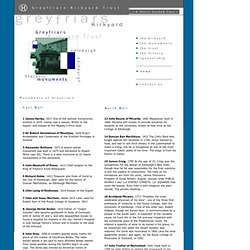
Harlay was a lawyer, Writer to the Signet, and Keeper of His Majesty's Privy Seal. 2 Sir Robert Dennistoun of Mountjoy, 1626 King's Ambassador and Conservator of the Scottish Privileges in Holland 3 Alexander Bethune, 1672 A lawyer whose monument was built in 1675 and attributed to Robert Milne (see 50). There is a later memorial to Dr Spens incorporated in the stonework. 4 John Nasmyth of Posso, 1613 Chief surgeon to the King of France's Scots Bodyguard. Bloody Mackenzie « travelcreepster. Tags abandoned, Battle of Bothwell Bridge, Black Mausoleum, Bloody Mackenzie, Bluidy Mackenzie, Bobby the terrier, bruises, burial vault, cemetery, conventers prison, creepy, crypt, desecrated tomb of George Mackenzie, Edinburgh police department, execution, George Mackenzie, ghost, ghostly occurrences, ghosts, Grefriars Bobby, Greyfriar Bobby, Greyfriar Kirkyard, haunted, horror, John Gray, Lord Advocate, militant Presbyterians, night watchman, Old Town Edinburgh, overtoun bridge, paranormal, paranormal activity, phantoms, poltergeist, scary, Scotland, scrapes, Sir George Mackenzie, skye terrier, spirits, spooky, strange, tomb, UK, vigil, weird Greyfriar Kirkyard is a five century old cemetery in Old Town Edinburgh, which plays home to two ghosts, or possibly three.

The latter two are the phantoms of a skye terrier named Bobby, and his owner John Gray, but they don’t really do much. We’ve moved! Follow the link to finish the story. Like this: Like Loading... Greyfriars Kirkyard, Edinburgh. Greyfriars Kirkyard - Edinburgh visitor guide showing a virtual tour of 'Greyfriars Kirkyard' linked to an interactive map with local and travel information. 360° panoramas from Lothian.
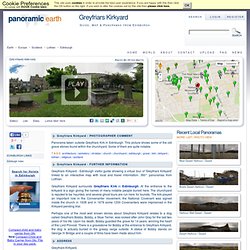
Greyfriars Kirkyard surrounds Greyfriars Kirk in Edinburgh. At the entrance to the kirkyard is a sign giving the names of many notable people buried here. The churchyard is reputed to be haunted, and several ghost tours are run here for tourists. History of Greyfriars Kirkyard in Edinburgh Old Town. The site occupied by Greyfriars Kirk and the very well known graveyard surrounding it has had religious connections from very early times.
In 1436 James the 1st founded a Franciscan Convent devoted to the order of Observatines in the area of the Grassmarket and the ground where the kirk now stands formed at least part of the garden of the convent. Getting to Edinburgh by Coach Long-distance coach tickets to Edinburgh from £15. Guaranteed seats on comfortable coach, overnight or daytime journeys. In 1547 the monastery was burned during the English invasion of Scotland. The next significant episode in the pre-history of Greyfriars occurred in 1562 when Mary Queen of Scots granted the former convent garden to the Town Council for use as a burial ground. Overview of Greyfriars Kirk. The ghosts of Greyfriars : Scotland Magazine Issue 37. On a summer’s day, Greyfriars Kirkyard is a very pleasant spot.
It boasts a fine view of nearby Edinburgh Castle; encloses a well-preserved section of the Flodden Wall; and is surrounded by ornate and impressive mausoleums. It is a popular haunt for tourists on the trail of Greyfriars Bobby, the loyal Skye terrier who stood guard over his master John Gray’s grave until he himself died, and office-workers seeking somewhere green and shady to enjoy a packed lunch. William McGonagall. William Topaz McGonagall (March 1825[1] – 29 September 1902) was a Scottish weaver, doggerel poet and actor. He won notoriety as an extremely bad poet who exhibited no recognition of, or concern for, his peers' opinions of his work.
He wrote about 200 poems, including his notorious "The Tay Bridge Disaster", which are widely regarded as some of the worst in English literature. Groups throughout Scotland engaged him to make recitations from his work and contemporary descriptions of these performances indicate that many listeners were appreciating McGonagall's skill as a comic music hall character.
Collections of his verse remain popular, with several volumes available today. Early life[edit] Although McGonagall was born and died in Greyfriars Parish, Edinburgh, he is almost solely linked with Dundee. Career[edit] McGonagall moved north and was apprenticed as a handloom weaver in Dundee, following in his father's footsteps.
William McGonagall. James Hutton. Through observation and carefully reasoned geological arguments, Hutton came to believe that the Earth was perpetually being formed; he recognized that the history of the Earth could be determined by understanding how processes such as erosion and sedimentation work in the present day. His theories of geology and geologic time,[4] also called deep time,[5] came to be included in theories which were called plutonism and uniformitarianism. Some of his writings anticipated the Gaia hypothesis. Early life and career[edit] After his degree Hutton returned to London, then in mid-1750 went back to Edinburgh and resumed chemical experiments with close friend, James Davie.
Their work on production of sal ammoniac from soot led to their partnership in a profitable chemical works,[8] manufacturing the crystalline salt which was used for dyeing, metalworking and as smelling salts and previously was available only from natural sources and had to be imported from Egypt. Farming and geology[edit] James Hutton. John Porteous (soldier) John Porteous. Greyfriar's Bobby.